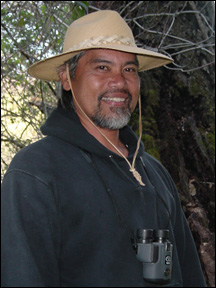 DINO LABISTE
DINO LABISTE
The PrimitiveWays Clan
PrimitiveWays began in 1998 and is produced
by
 DINO LABISTE
DINO LABISTEDino Labiste's love of nature came from growing up in Hawai'i. Surrounded by the lush maulukua (forest) and the deep blue moana (ocean), he enjoyed hiking in the mountains as well as surfing and canoeing in the ocean swells. Dino was taught to place an offering of a folded leaf from the ki plant at the beginning of each hike, asking for safe passage for entering the tropical jungle. He also learned to respect the power of the ocean and to be sensitive to her many gifts of seafood.
Dino's interest in traditional Kanaka Oiwi (Hawaiian culture) was fueled by the cultural history classes in grade school and his first visit to the Bishop Museum. How did the early Polynesians create all of those beautiful artifacts with just stone tools and cordage? He began talking to kupuna who were still into the old ways of making mea Hawai'i (things Hawaiian) and pouring over research literature on Oceania, as well as Southeast Asia.
His studies in design and art soon took Dino to California to receive his academic degree at California College of the Arts. The various wilderness habitats in California opened up new opportunities to explore the rivers, mountains, ocean shorelines, as well as the deserts. While on the Mainland, Dino soon turned his interest to indigenous cultures, Stone Age technology and archaeology. His thirst for knowledge took him to various museums throughout Hawaii, California, Nevada & Canada, research libraries at universities and involvement with native groups. Dino got the opportunity to examine and look at various California Native material culture artifacts stored in the Phoebe A. Hearst Museum of Anthropology at the University of California in Berkeley.
Dino works as a Naturalist for a regional park. He has written articles for the Bulletin of Primitive Technology periodical and the Wilderness Way magazine. Dino has taught workshops and presented demonstrations of indigenous skills at the Oakland Museum in Oakland, the Miwok Archaeological Preserve of Marin at the Point Reyes National Seashore, the Indian Education Center in Marysville, Ohlone Day at Henry Cowell Redwoods State Park, The Gathering of Ohlone Peoples at Coyote Hills Regional Park, the Native California Fall Gathering at San Luis Reservoir State Recreation Area, the Maidu Museum in Roseville, the United Auburn Indian Community in Auburn, the Santa Cruz Indian Council in Watsonville, the Middletown Rancheria in Middletown, the Rattlesnake Rendezvous at Sunol Regional Wilderness, the Coyote Hills Knap-In at Coyote Hills Regional Park, the Acorn Gathering in San Luis Obispo, the Yosemite Knap-In at Yosemite National Park, the Buckeye Gathering at Lake Concow, Winter Count in Arizona and the Rabbitstick Rendezvous in Idaho. Dino has done presentations on ethnobotany at Cal State East Bay in Hayward. He was also an aikido instructor at the Enbukan Dojo.
Dino is teaching classes on indigenous skills, Stone Age technology and wilderness survival competence through his "Skills of the Past" workshops. The old saying, "Know truth by your own direct experience", is basic to learning any skill. You learn by observing, deducing and applying, which leads to a deeper understanding and respect of life and the environment. Start your journey with "shoshin", a beginner's mind.
Knowledge is not complete until it is passed on. But, the knowledge that is passed on must be complete. Look to the kupuna to help us grow in numerous ways. They are a source of experience, knowledge, guidance, strength and inspiration to the next generations.
Dino Labiste can be contacted at KahikoArts@yahoo.com
Check out the Trading Post for artwork
for sale by Dino.
"Tule Basket Weaving" produced by Lowe + Helzer
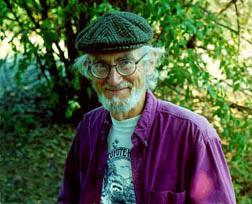 DICK BAUGH
DICK BAUGHDick Baugh has been interested in ancestral skills since childhood. When he was eight-years-old, his dad and he tried unsuccessfully to start a fire with a bow drill. He finally achieved ignition 25 years later. With so many people boasting about the speed with which they can start a friction fire, who do you know who can do it that slowly?
Dick has graduate degrees in electrical engineering and has had a 40+ year professional career in electronics research. He has worked on atomic time keeping and storage of computer information with magnetic bubbles, rigid disk drives and magnetic tape.
Dick gets particular enjoyment in applying modern scientific analysis and measurement techniques to primitive technology. He wrote a paper, entitled "Atlatl Dynamics", published in Lithic Technology, which analyzes high speed video data taken of a projectile being thrown with an atlatl. He has also published several articles on fire-by-friction in the Bulletin of Primitive Technology.
His other interests are archery equipment, lithic technology, didjeridoo making and playing, creating steel knives and teaching primitive technology to children.
Dick Baugh can be contacted at richardbaugh@att.net
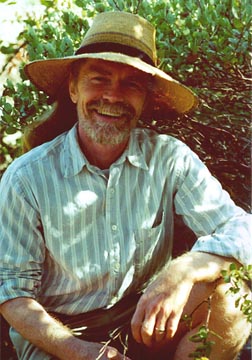 BOB GILLIS
BOB GILLISBob Gillis, owner of Shelter Systems, a tent company, has a long history of design in the tent industry. He has licensed tents to The North Face, Sierra Designs, Mountain Hardware, Marmot and others. Bob has been granted twelve U.S. patents, from structural concepts to the molded clips used in the construction of Shelter Systems' dome tents. He revolutionized the tent industry in 1976 by designing the first geodesic backpacking tent, The Oval Intention, using tensegrity design principles. Most of the backpacking tents using flexed poles that you see on the market today are covered by his patents.
Bob has a strong interest in making things with his hands and in how our "primitive" ancestors used their hands and mind to survive and flourish. He feels that by learning about who we were, we begin to understand who we are. The best way to know this is by doing. Bob feels the PrimitiveWays website is an important and excellent way to share the "how to".
Bob Gillis can be contacted at bob@shelter-systems.com
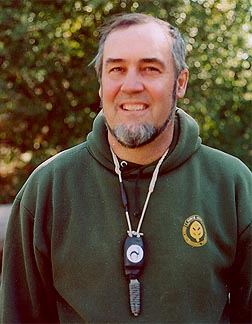 NORM KIDDER
NORM KIDDERNorm Kidder has always felt most at home in the outdoors, growing up in rural Indiana and New Jersey. He was an Eagle Scout back when Scouting emphasized old style campcraft skills. Norm has a degree in Biology from Antioch College, Yellow Springs, Ohio, where he focused on the evolution of human behavior compared to social primates and social predators. In 1972, he started work as a Naturalist with the East Bay Regional Park District at Coyote Hills Regional Park, where his main interest was the interpretation of the local Ohlone Indians. At the urging of his wife and fellow Naturalist, Jan Southworth, Norm began replication of artifacts and houses. He assisted her in 1979 with the construction of a Tule Boat that she paddled across San Francisco Bay. That same year they took a class from Craig Bates in Yosemite and got more seriously into skills such as fire and cordage, netting and woodworking. The Tule Boat voyages also brought Norm together with Dick Baugh. They then collaborated on the first Old Ways Workshop (1980), Stone-Age Olympics and Stone-Age Weekend (now the Rattlesnake Rendezvous). He began instructing at the Rabbitstick Rendezvous in Idaho in 1992 and at the Winter Count Gathering at its inception in 1995. Since 1996, Norm has been the Supervising Naturalist at Sunol-Ohlone Regional Wilderness. He was selected as a Member of the Board of the Society of Primitive Technology in 1997. Norm has contributed many articles to the Bulletin of Primitive Technology. Although Norm can teach most of the basic primitive skills, he likes to emphasize the basics: fire, fiber, shelter and simple tools that are the heritage of all humanity.
Norm runs a small business - The Old Ways Workshop, through which he consults, constructs exhibits and replicates artifacts for teachers and museums. He also sells artifacts and artwork (woodcarving and gourd containers) to the public, teaches outdoor survival skills, and markets survival kits. Read the article about Norm Kidder in the San Francisco Chronicle newspaper.
Norm Kidder can be contacted at atlatl1@aol.com
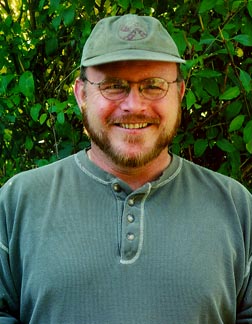 CHUCK KRITZON
CHUCK KRITZONChuck Kritzon's interest in the past and old ways skills has been with him for a long time. When he was 10 years old, he was fortunate to see some Chumash Indian cave paintings in the Santa Barbara Mountains. The same year he visited the California State Indian Museum (SIM) in Sacramento with his family. Looking back, he realized that this was when he began his journey to gain the knowledge and skills that have become his passion in life. Many years would pass before his real education would begin.
In 1991, by chance, Chuck heard about Ishi Day to be celebrated at the SIM. There was to be someone there demonstrating obsidian knapping. On that rainy October day, he was fortunate to meet the first of many mentors and teachers. When he arrived, Brian Smith (Wanasi), was sitting in the corner of the museum on a large tarp knapping arrowheads. Chuck spent the rest of the day sitting on the floor watching, listening and asking a zillion questions. Chuck was fortunate to find a first teacher who spoke to the very heart of his desire to learn. Brian taught primitive skills from a Native American viewpoint: having respect for the natural world, making offerings and giving thanks for materials gathered. Trying to sense what the earth and all the plants and animals are trying to tell us. An entirely holistic view of old ways skills. This may seem "out there" to many, but it was exactly how Chuck wished to learn.
Brian told Chuck that he taught classes a Point Reyes National Seashore at the reconstructed Coast Miwok village there. A whole new world was opening up for Chuck. He could not get enough of the classes being taught there by Brian and others. It was not until later that Chuck realized how fortunate he was having the caliber of teachers he did. Peg Mathewson, Steven Edholm and Tamara Wilder, Bill Mulloy, Joe Dabil, Bev Ortiz and many others.
The day Chuck met Brian, he also learned that docent training for the SIM would begin soon. Chuck signed up, but the training was delayed a year due to budget cutbacks. This proved to be fortunate. By the time Chuck became a docent, he was glad to have a venue to practice and share the many skills he had been learning. Chuck had the opportunity to demonstrate flintknapping, making cordage, fire and arrows, as well as pecking and grinding. During this time he threw himself into learning all he could about California Native Culture. Chuck also began to educate himself about the Rock Art of the California Indian People, which eventually lead to Petroglyphics, his company that replicates petroglyphs and pictograph images on natural stone and bone pendants and slate coasters.
It was at this time he learned about the Society of Primitive Technology and became a member. In the first bulletin, he read about another California Bay Area based teacher, Norm Kidder. During a visit to Norm's area on one business day, Chuck stopped in at Coyote Hills Regional Park and introduced himself to Norm. Learning that Norm and Dick Baugh also taught skills there, Chuck became a regular attendee at the monthly classes for the next few years and began to participate in the "Rattlesnake Rendezvous / Stone-Age weekend" that Norm held every year at Sunol-Ohlone Regional Wilderness.
Over time, Chuck began helping Norm and Dick with the classes at Coyote Hills and even taught a few classes at the Rabbitstick Rendezvous one year. During his time at the SIM, and currently at Indian Grinding Rock State Historic Park in Pine Grove, California, Chuck has organized and presented enrichment training for other docents and park staff.
The focus of his study of Rock Art became increasingly world wide and in the summer of 1999, Chuck was invited and presented a series of lectures and demonstrations about the cave painting of paleolithic Europe at The California Academy of Science in San Francisco, in conjunction with the "Missing Links Alive!" exhibit.
In 1998 and 1999, he also participated in presenting classes in Alberta, Canada for the Junior Forest Wardens youth organization.
Along with his Petroglyphics business, Chuck is also teaching classes at the Maidu Interpretive Center in Roseville, California.
Chuck said, "I am pleased to be part of this on-line endeavor with Norm, Dick, Bob, Ken, and Dino. With the combined knowledge, skills, and enthusiasm of this group, I am confident that it will grow and flourish into an important educational resource for both experienced and novice old ways skills practitioners."
Chuck Kritzon can be contacted at chuckk@petroglyphics.com
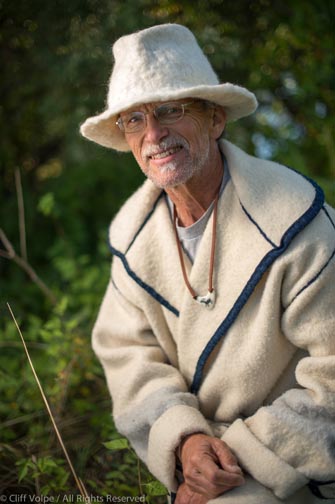 KEN
PEEK
KEN
PEEKKen's life-long interest in nature and the outdoors began with numerous family camping trips to the Sierra Nevada range as well as the Northwest and Southwest. It seems he's always wanted to make things by hand, and this interest was mentored early on by his great-grandfather, a make-anything carpenter from the Old Country, and a favorite uncle whose hobbies included woodworking, metalworking, jewelry, and lapidary work. The rockhound in Ken was encouraged early on, and to this day he still spends most of his time studying the ground while outdoors! Later on, when an interest in flint-knapping developed, it proved to be the best of all worlds: being out in nature, rock collecting, and hand-crafting at its most fundamental, all rolled into one! In the late 90's, Ken was instrumental in organizing the first Coyote Hills Knap-In in Fremont, CA, which has become an annual event attended by numerous Bay Area knappers. Although stone-working was his first love, he's since branched out and tried his hand at everything from gourd-crafting to basketry, and just about any craft involving plants and natural materials. After thirty-plus years with the California Native Plant Society, he definitely considers himself to be a "plant person", and is constantly seeking new ethnobotanical information regarding plant uses. Ken's demos on Native technologies and plant uses have been incorporated into his children's school curriculum, and his local school board recently awarded him a certificate of recognition for "bringing history alive" and "inspiring many future archaeologists and historians."
"Working with kids and generating enthusiasm in them has definitely become a focus for me," Ken says. "If there's one message I like to leave with them, it's that everything we have, need, and see around us comes from the Earth. I hope that my interests will help people re-connect with the natural world that sustains us all".
Ken Peek can be contacted at kspeek123@att.net
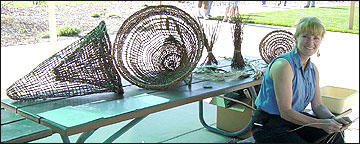 SUSAN LABISTE
SUSAN LABISTE
Sue has always had an interest in the outdoors. Growing up in the Bay Area, she spent family vacations in the Sierra and the Trinity Alps, and at the coast camping, back-packing and fishing. She accompanied her father and brother on bow-hunting trips, helping to track deer, learning to read animal signs and how to skin and dress wild game. At home, she was an inveterate rock turner, tree climber, and reader of natural history books. At a young age she felt the spiritual uplift of uncultivated landscapes and a reverence for these places. Though she pursued a career as a nurse, an interest in California flora and uses of native plants led Sue to volunteer as a docent at Sunol-Ohlone Regional Wilderness. The naturalists needed replacements for items of material culture used in their California Indian program. Under the direction of Joanne Dean-Freemire and Norm Kidder, she took on the task of creating a new bark skirt, pine nut and olivella shell necklaces, and a twined rabbit-skin blanket. With these projects came a realization that in practicing primitive technologies, both the learning and the doing combined and fulfilled her interests. Since that time she has taken on the life long process of learning from others and learning by doing with projects including: brain tanning hides and buckskin, primitive clothing and tools, coiled and twined basketry, ethnobotany and food processing, creating and home-firing native clay pottery. These projects, with their ethic of asking and giving thanks for materials, fit with Sue's sense of the value inherent in wild places.
Since her 1997 primitive technology "epiphany", Sue returned to college to earn a BA in Biology at Cal State East Bay. After graduation she worked for Livermore Area Recreation and Parks as a ranger/naturalist.
Sue is a registered nurse, currently working at a surgery center. When she isn't practicing the healing arts, she stays involved in teaching the skills she has learned. Sue has developed and presented workshops at the Miwok Archeological Preserve of Marin in Point Reyes National Seashore, CA, the United Auburn Indian Community in Lincoln, CA and the Maidu Interpretive Center in Roseville, CA. She has also conducted workshops at the Oakland Museum in Oakland, the Rattlesnake Rendezvous at Sunol-Ohlone Regional Wilderness, Winter Count in Arizona and at the Rabbitstick Rendezvous in Idaho. Sue and Dino Labiste develop and present interpretive programs on Native American culture and on Early Man to local elementary school children through Outside Educators. She also develops and conducts classes at the Math/Science Nucleus in Fremont, CA. Sue has reproduced items of material culture used to augment school programs about California Native Americans. These include, willow fish trap, sedge, redbud and willow coiled basket, whole shoot open twined burden basket with cordage tumpline, rabbit skin blanket, tule mat, bark apron, brain-tanned buckskin backskirt, stone mortar and pestle, bead and shell necklaces, digging stick, awls, scapular tule saw, acorn mush paddle, toys, fletched arrow and obsidian arrow points. She also helped replicate a tule house at Tyson Lagoon for the Math/Science Nucleus.
Sue feels the construction of useful tools and items of material culture gives the primitive technologist a kind of hands-on appreciation of stone-age cultures, a window to a common ancestry of hunter/gatherers who recognized a more intimate and immediate association with natural forces and living things
![]()
© PrimitiveWays 2020